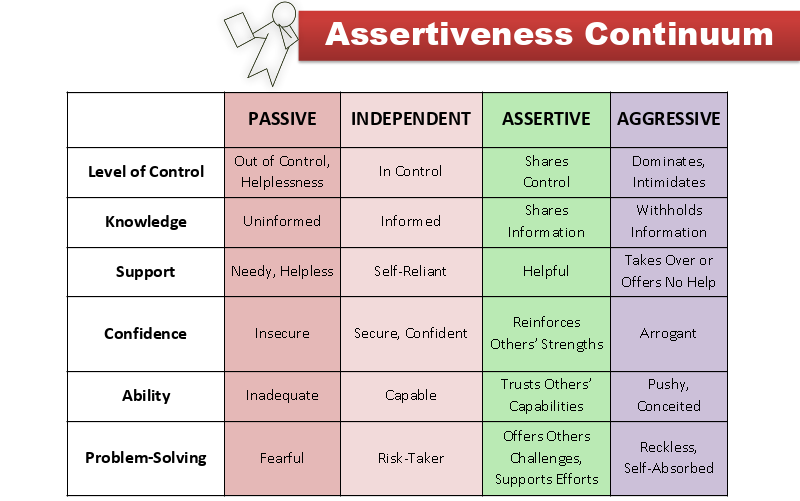Assertion Without Aggression: A Tightrope Test of Supervisory Skills
Assertiveness in the workplace is like a circus performer walking a tightrope. If the performer is overconfident in his abilities, he moves too quickly and falls. If the performer is too afraid of taking a risk, he’ll never reach his end goal. Get the balance right, and your supervisory skills will make you a superstar.
Here’s a great definition of what it means to be assertive:
Assertiveness: “Being authentic in our dealings with others; treating our values and personas with decent respect in social contexts; refusing to take the reality of who we are or what we esteem in order to avoid disapproval; the willingness to stand up for ourselves and our ideas in appropriate ways in appropriate contexts.” - Nathaniel Branden
But how do you find the right balance of assertiveness to improve your effectiveness as a leader?
A Balancing Act to Enhance Your Supervisory Skills
First, a wake-up call to the many benefits of assertiveness. The right mix lets you:
- Relate to others as equals
- Handle situations objectively
- Focus on the present situation
- Retain self-respect and respect of others
- Increase self-confidence
- Acknowledge rights of others
- Feel in control of your life
- Fully participate in conversations and relationships
What a wonderful list of workplace (and life) benefits, amirite?
The problem is, we’re built poorly for handling stressful situations with the appropriate levels of candor and confidence. Our emotions work against us, and there’s a real physiological response that kicks in, too. This is perfectly normal! We just need to expect it and work through it instead of letting strong feelings derail us.
This is especially true when you’re caught by surprise. You might feel ambushed. Attacked. It’s the modern day version of encountering a lion face-to-face -- your internal fight-or-flight kicks in.
Not Assertive Enough?
Assertiveness isn’t about putting on an artificial face to be something you’re not. Take, for example, introverted folks who are told they should be more assertive. Forcing immediate participation can lead to great discomfort -- a command to speak up results, more often, in false agreement being vocalized rather than true opinions being expressed.
When people hold back, it’s often due to:
- Fear of criticism
- Fear of conflict
- Not feeling they have the right to impose their views
- Misplaced compassion
- Indecisiveness
- Desire to be liked
Passive employees go along with others’ suggestions when they really want to say “no.” They work hard to pacify others. They mirror others and reflect back the hopes, wishes, desires, and plans of others much more than they radiate their own goals, thoughts, and dreams. In doing so, they limit themselves and their teams. They do not fully contribute.
Too Assertive?
Other employees take a different approach. They feel a strong need to impose their views on everyone around them. They want their way to be accepted by everyone, and they are willing to fight for it.
If others do not give in, they may become angry or at least appear to be angry, using a louder voice and a magnified stance to dominate or intimidate others. In their need to enforce their wishes, they ignore or trample on the wishes of others. (These behaviors are often accompanied by other signs of poor active listening skills).
Time to Check Yourself
Neither extreme is entirely effective. It might feel good in the moment as it gets the desired effect of either avoiding conflict or getting one’s own way, but it does not position people to be effective as leaders.

There are six ways you can evaluate yourself and determine if your behavior indicates you are assertive. Think about a responsibility or project you are working on now. Do any of your behaviors fail to fall in the green column?
When you get assertiveness right, you relate to others with less conflict, anxiety, and resentment.
How to Prepare Yourself
It can be challenging to get assertiveness right. Keep it in check with these steps for conducting a challenging conversation, especially if you’re on the aggressive end of the spectrum:
1. Inquire
Set aside your assumptions and demonstrate you’re willing to listen with an open mind. An attitude of interest and curiosity will open the dialogue productively. You’ll have a chance to learn about the other perspective. Setting aside an emotional reaction will provide you with more insight.
2. Acknowledge
This is how you make the conversation safe and keep control so it doesn’t become emotional or combative. You paraphrase and explain back what you heard. You can even acknowledge your own feelings in the spirit of cooperation and openness. Saying things like “I see that this is really important to you” validates the other person’s feelings without necessarily validating their position.
3. Advocate
After you’ve fully heard the other person out, it’s your turn to clarify your position and advocate for it. You can do this without minimizing the other person’s position or coming across as competitive. You are simply stating what’s important to you. This is in addition to what your teammate said, not instead of what your teammate said.
4. Collaborate
With both positions on the table, you can shift the dialogue to collaborative problem solving. Start by saying something like, “Now that we’ve each had a chance to understand what’s important to us, let’s try to come to a solution that will meet as many of our needs as possible. What do you think would work?”
You can keep this part of the conversation positive by building on the ideas someone offers rather than dismissing them.
5. Return
Go back to step one if the process breaks down at any point. Your inquiry should be directed by your intent to reach a solution and communicate candidly for the good of the organization. Statements for defusing the situation might sound like this: “Let’s slow down. Please help me understand what part of this you are most concerned about.”
Relationships Matter
Nobody said leadership would be easy! But the way we communicate with others in challenging circumstances ultimately determines the quality of our relationships and overall effectiveness at work.
With a balanced approach to leadership, you can speak candidly while still building credibility.

